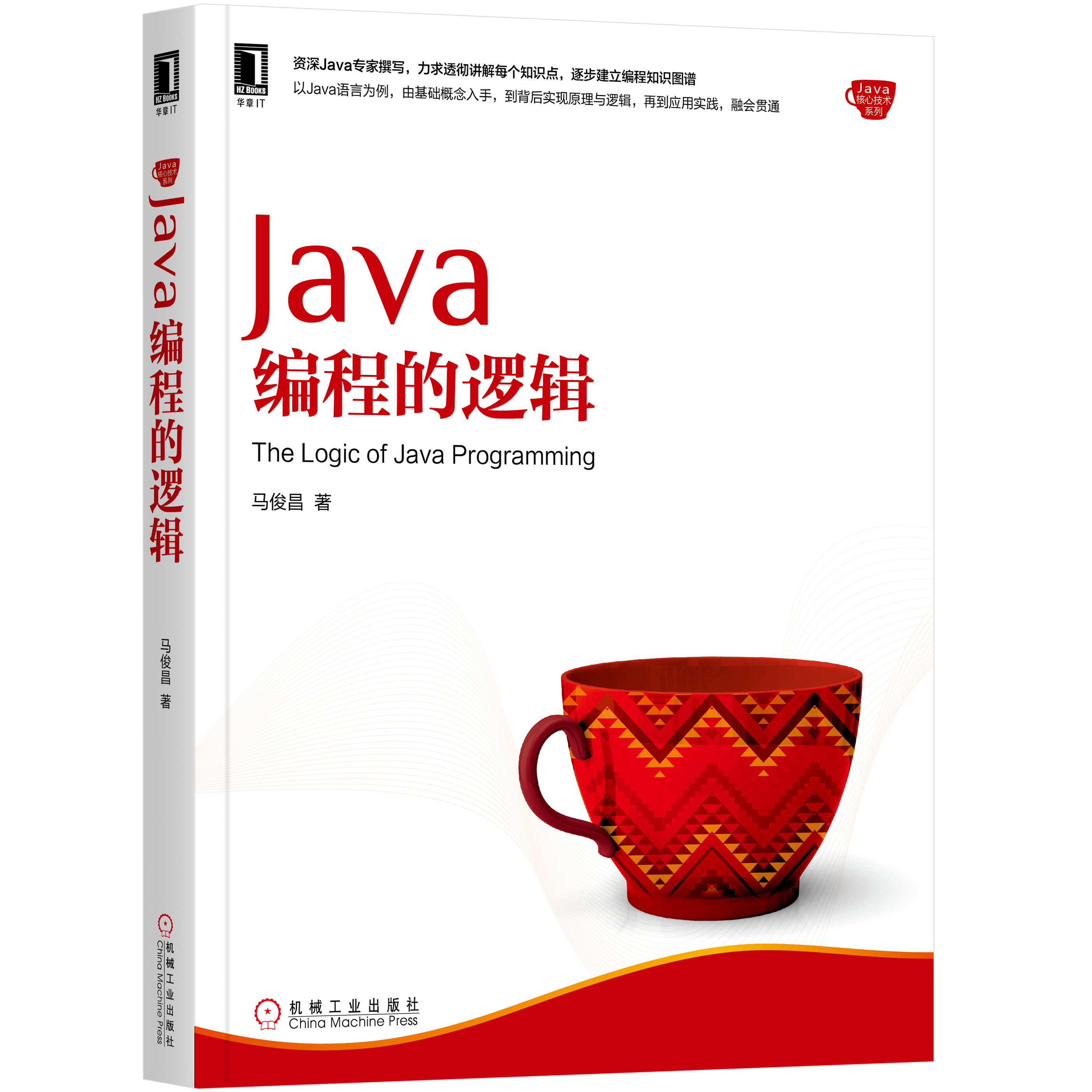计算机程序的思维逻辑 (89) - 正则表达式 (中)
Posted 老马说编程
tags:
篇首语:本文由小常识网(cha138.com)小编为大家整理,主要介绍了计算机程序的思维逻辑 (89) - 正则表达式 (中)相关的知识,希望对你有一定的参考价值。
本系列文章经补充和完善,已修订整理成书《Java编程的逻辑》,由机械工业出版社华章分社出版,于2018年1月上市热销,读者好评如潮!各大网店和书店有售,欢迎购买,京东自营链接:http://item.jd.com/12299018.html

上节介绍了正则表达式的语法,本节介绍相关的Java API。
正则表达式相关的类位于包java.util.regex下,有两个主要的类,一个是Pattern,另一个是Matcher。Pattern表示正则表达式对象,它与要处理的具体字符串无关。Matcher表示一个匹配,它将正则表达式应用于一个具体字符串,通过它对字符串进行处理。
字符串类String也是一个重要的类,我们在29节专门介绍过String,其中提到,它有一些方法,接受的参数不是普通的字符串,而是正则表达式。此外,正则表达式在Java中是需要先以字符串形式表示的。
下面,我们先来介绍如何表示正则表达式,然后探讨如何利用它实现一些常见的文本处理任务,包括切分、验证、查找、和替换。
表示正则表达式
转义符 \'\\\'
正则表达式由元字符和普通字符组成,字符\'\\\'是一个元字符,要在正则表达式中表示\'\\\'本身,需要使用它转义,即\'\\\\\'。
在Java中,没有什么特殊的语法能直接表示正则表达式,需要用字符串表示,而在字符串中,\'\\\'也是一个元字符,为了在字符串中表示正则表达式的\'\\\',就需要使用两个\'\\\',即\'\\\\\',而要匹配\'\\\'本身,就需要四个\'\\\',即\'\\\\\\\\\',比如说,如下表达式:
<(\\w+)>(.*)</\\1>
对应的字符串表示就是:
"<(\\\\w+)>(.*)</\\\\1>"
一个简单规则是,正则表达式中的任何一个\'\\\',在字符串中,需要替换为两个\'\\\'。
Pattern对象
字符串表示的正则表达式可以被编译为一个Pattern对象,比如:
String regex = "<(\\\\w+)>(.*)</\\\\1>";
Pattern pattern = Pattern.compile(regex);
Pattern是正则表达式的面向对象表示,所谓编译,简单理解就是将字符串表示为了一个内部结构,这个结构是一个有穷自动机,关于有穷自动机的理论比较深入,我们就不探讨了。
编译有一定的成本,而且Pattern对象只与正则表达式有关,与要处理的具体文本无关,它可以安全地被多线程共享,所以,在使用同一个正则表达式处理多个文本时,应该尽量重用同一个Pattern对象,避免重复编译。
匹配模式
Pattern的compile方法接受一个额外参数,可以指定匹配模式:
public static Pattern compile(String regex, int flags)
上节,我们介绍过三种匹配模式:单行模式(点号模式)、多行模式和大小写无关模式,它们对应的常量分别为:Pattern.DOTALL,Pattern.MULTILINE和Pattern.CASE_INSENSITIVE,多个模式可以一起使用,通过\'|\'连起来即可,如下所示:
Pattern.compile(regex, Pattern.CASE_INSENSITIVE | Pattern.DOTALL)
还有一个模式Pattern.LITERAL,在此模式下,正则表达式字符串中的元字符将失去特殊含义,被看做普通字符。Pattern有一个静态方法:
public static String quote(String s)
quote()的目的是类似的,它将s中的字符都看作普通字符。我们在上节介绍过\\Q和\\E,\\Q和\\E之间的字符会被视为普通字符。quote()基本上就是在字符串s的前后加了\\Q和\\E,比如,如果s为"\\\\d{6}",则quote()的返回值就是"\\\\Q\\\\d{6}\\\\E"。
切分
简单情况
文本处理的一个常见需求是根据分隔符切分字符串,比如在处理CSV文件时,按逗号分隔每个字段,这个需求听上去很容易满足,因为String类有如下方法:
public String[] split(String regex)
比如:
String str = "abc,def,hello"; String[] fields = str.split(","); System.out.println("field num: "+fields.length); System.out.println(Arrays.toString(fields));
输出为:
field num: 3
[abc, def, hello]
不过,有一些重要的细节,我们需要注意。
转义元字符
split将参数regex看做正则表达式,而不是普通的字符,如果分隔符是元字符,比如. $ | ( ) [ { ^ ? * + \\,就需要转义,比如按点号\'.\'分隔,就需要写为:
String[] fields = str.split("\\\\.");
如果分隔符是用户指定的,程序事先不知道,可以通过Pattern.quote()将其看做普通字符串。
将多个字符用作分隔符
既然是正则表达式,分隔符就不一定是一个字符,比如,可以将一个或多个空白字符或点号作为分隔符,如下所示:
String str = "abc def hello.\\n world";
String[] fields = str.split("[\\\\s.]+");
fields内容为:
[abc, def, hello, world]
空白字符串
需要说明的是,尾部的空白字符串不会包含在返回的结果数组中,但头部和中间的空白字符串会被包含在内,比如:
String str = ",abc,,def,,"; String[] fields = str.split(","); System.out.println("field num: "+fields.length); System.out.println(Arrays.toString(fields));
输出为:
field num: 4
[, abc, , def]
找不到分隔符
如果字符串中找不到匹配regex的分隔符,返回数组长度为1,元素为原字符串。
切分数目限制
split方法接受一个额外的参数limit,用于限定切分的数目:
public String[] split(String regex, int limit)
不带limit参数的split,其limit相当于0。关于limit的含义,我们通过一个例子说明下,比如字符串是"a:b:c:",分隔符是":",在limit为不同值的情况下,其返回数组如下表所示:

Pattern的split方法
Pattern也有两个split方法,与String方法的定义类似:
public String[] split(CharSequence input) public String[] split(CharSequence input, int limit)
与String方法的区别是:
- Pattern接受的参数是CharSequence,更为通用,我们知道String, StringBuilder, StringBuffer, CharBuffer等都实现了该接口;
- 如果regex长度大于1或包含元字符,String的split方法会先将regex编译为Pattern对象,再调用Pattern的split方法,这时,为避免重复编译,应该优先采用Pattern的方法;
- 如果regex就是一个字符且不是元字符,String的split方法会采用更为简单高效的实现,所以,这时,应该优先采用String的split方法。
验证
验证就是检验输入文本是否完整匹配预定义的正则表达式,经常用于检验用户的输入是否合法。
String有如下方法:
public boolean matches(String regex)
比如:
String regex = "\\\\d{8}";
String str = "12345678";
System.out.println(str.matches(regex));
检查输入是否是8位数字,输出为true。
String的matches实际调用的是Pattern的如下方法:
public static boolean matches(String regex, CharSequence input)
这是一个静态方法,它的代码为:
public static boolean matches(String regex, CharSequence input) { Pattern p = Pattern.compile(regex); Matcher m = p.matcher(input); return m.matches(); }
就是先调用compile编译regex为Pattern对象,再调用Pattern的matcher方法生成一个匹配对象Matcher,Matcher的matches()返回是否完整匹配。
查找
查找就是在文本中寻找匹配正则表达式的子字符串,看个例子:
public static void find(){ String regex = "\\\\d{4}-\\\\d{2}-\\\\d{2}"; Pattern pattern = Pattern.compile(regex); String str = "today is 2017-06-02, yesterday is 2017-06-01"; Matcher matcher = pattern.matcher(str); while(matcher.find()){ System.out.println("find "+matcher.group() +" position: "+matcher.start()+"-"+matcher.end()); } }
代码寻找所有类似"2017-06-02"这种格式的日期,输出为:
find 2017-06-02 position: 9-19
find 2017-06-01 position: 34-44
Matcher的内部记录有一个位置,起始为0,find()方法从这个位置查找匹配正则表达式的子字符串,找到后,返回true,并更新这个内部位置,匹配到的子字符串信息可以通过如下方法获取:
//匹配到的完整子字符串 public String group() //子字符串在整个字符串中的起始位置 public int start() //子字符串在整个字符串中的结束位置加1 public int end()
group()其实调用的是group(0),表示获取匹配的第0个分组的内容。我们在上节介绍过捕获分组的概念,分组0是一个特殊分组,表示匹配的整个子字符串。除了分组0,Matcher还有如下方法,获取分组的更多信息:
//分组个数 public int groupCount() //分组编号为group的内容 public String group(int group) //分组命名为name的内容 public String group(String name) //分组编号为group的起始位置 public int start(int group) //分组编号为group的结束位置加1 public int end(int group)
比如:
public static void findGroup() { String regex = "(\\\\d{4})-(\\\\d{2})-(\\\\d{2})"; Pattern pattern = Pattern.compile(regex); String str = "today is 2017-06-02, yesterday is 2017-06-01"; Matcher matcher = pattern.matcher(str); while (matcher.find()) { System.out.println("year:" + matcher.group(1) + ",month:" + matcher.group(2) + ",day:" + matcher.group(3)); } }
输出为:
year:2017,month:06,day:02
year:2017,month:06,day:01
替换
replaceAll和replaceFirst
查找到子字符串后,一个常见的后续操作是替换。String有多个替换方法:
public String replace(char oldChar, char newChar) public String replace(CharSequence target, CharSequence replacement) public String replaceAll(String regex, String replacement) public String replaceFirst(String regex, String replacement)
第一个replace方法操作的是单个字符,第二个是CharSequence,它们都是将参数看做普通字符。而replaceAll和replaceFirst则将参数regex看做正则表达式,它们的区别是,replaceAll替换所有找到的子字符串,而replaceFirst则只替换第一个找到的,看个简单的例子,将字符串中的多个连续空白字符替换为一个:
String regex = "\\\\s+"; String str = "hello world good"; System.out.println(str.replaceAll(regex, " "));
输出为:
hello world good
在replaceAll和replaceFirst中,参数replacement也不是被看做普通的字符串,可以使用美元符号加数字的形式,比如$1,引用捕获分组,我们看个例子:
String regex = "(\\\\d{4})-(\\\\d{2})-(\\\\d{2})";
String str = "today is 2017-06-02.";
System.out.println(str.replaceFirst(regex, "$1/$2/$3"));
输出为:
today is 2017/06/02.
这个例子将找到的日期字符串的格式进行了转换。所以,字符\'$\'在replacement中是元字符,如果需要替换为字符\'$\'本身,需要使用转义,看个例子:
String regex = "#"; String str = "#this is a test"; System.out.println(str.replaceAll(regex, "\\\\$"));
如果替换字符串是用户提供的,为避免元字符的的干扰,可以使用Matcher的如下静态方法将其视为普通字符串:
public static String quoteReplacement(String s)
String的replaceAll和replaceFirst调用的其实是Pattern和Matcher中的方法,比如,replaceAll的代码为:
public String replaceAll(String regex, String replacement) { return Pattern.compile(regex).matcher(this).replaceAll(replacement); }
边查找边替换
replaceAll和replaceFirst都定义在Matcher中,除了一次性的替换操作外,Matcher还定义了边查找、边替换的方法:
public Matcher appendReplacement(StringBuffer sb, String replacement) public StringBuffer appendTail(StringBuffer sb)
这两个方法用于和find()一起使用,我们先看个例子:
public static void replaceCat() { Pattern p = Pattern.compile("cat"); Matcher m = p.matcher("one cat, two cat, three cat"); StringBuffer sb = new StringBuffer(); int foundNum = 0; while (m.find()) { m.appendReplacement(sb, "dog"); foundNum++; if (foundNum == 2) { break; } } m.appendTail(sb); System.out.println(sb.toString()); }
在这个例子中,我们将前两个"cat"替换为了"dog",其他"cat"不变,输出为:
one dog, two dog, three cat
StringBuffer类型的变量sb存放最终的替换结果,Matcher内部除了有一个查找位置,还有一个append位置,初始为0,当找到一个匹配的子字符串后,appendReplacement()做了三件事情:
- 将append位置到当前匹配之前的子字符串append到sb中,在第一次操作中,为"one ",第二次为", two ";
- 将替换字符串append到sb中;
- 更新append位置为当前匹配之后的位置。
appendTail将append位置之后所有的字符append到sb中。
模板引擎
利用Matcher的这几个方法,我们可以实现一个简单的模板引擎,模板是一个字符串,中间有一些变量,以{name}表示,如下例所示:
String template = "Hi {name}, your code is {code}.";
这里,模板字符串中有两个变量,一个是name,另一个是code。变量的实际值通过Map提供,变量名称对应Map中的键,模板引擎的任务就是接受模板和Map作为参数,返回替换变量后的字符串,示例实现为:
private static Pattern templatePattern = Pattern.compile("\\\\{(\\\\w+)\\\\}"); public static String templateEngine(String template, Map<String, Object> params) { StringBuffer sb = new StringBuffer(); Matcher matcher = templatePattern.matcher(template); while (matcher.find()) { String key = matcher.group(1); Object value = params.get(key); matcher.appendReplacement(sb, value != null ? Matcher.quoteReplacement(value.toString()) : ""); } matcher.appendTail(sb); return sb.toString(); }
代码寻找所有的模板变量,正则表达式为:
\\{(\\w+)\\}
\'{\'是元字符,所以要转义,\\w+表示变量名,为便于引用,加了括号,可以通过分组1引用变量名。
使用该模板引擎的示例代码为:
public static void templateDemo() { String template = "Hi {name}, your code is {code}."; Map<String, Object> params = new HashMap<String, Object>(); params.put("name", "老马"); params.put("code", 6789); System.out.println(templateEngine(template, params)); }
输出为:
Hi 老马, your code is 6789.
小结
本节介绍了正则表达式相关的主要Java API,讨论了如何在Java中表示正则表达式,如何利用它实现文本的切分、验证、查找和替换,对于替换,我们演示了一个简单的模板引擎。
下一节,我们继续探讨正则表达式,讨论和分析一些常见的正则表达式。
(与其他章节一样,本节所有代码位于 https://github.com/swiftma/program-logic,位于包shuo.laoma.regex.c89下)
----------------
未完待续,查看最新文章,敬请关注微信公众号“老马说编程”(扫描下方二维码),从入门到高级,深入浅出,老马和你一起探索Java编程及计算机技术的本质。用心原创,保留所有版权。

以上是关于计算机程序的思维逻辑 (89) - 正则表达式 (中)的主要内容,如果未能解决你的问题,请参考以下文章